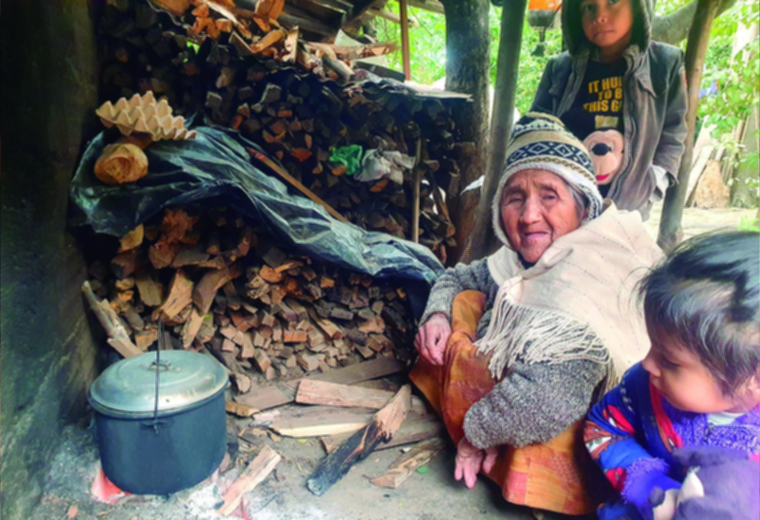June 14, 2023, 7:36 AM
June 14, 2023, 7:36 AM
Guillermina Gutiérrez, 83, wearing a pimp, blanket and wool sweater, rubs her hands by the fire to deal with the surazo, which is felt more in areas away from the capital of Santa Cruz, where the wind blows stronger.
Low temperatures hit much of the country with frost, snowfall and flooding. In Cuatro Cañadas recorded the first death attributed to the storm. It is about of a man who tried to cross a road eaten away by rain in his truck. He arrived in a state of hypothermia at the hospital, where he died.
In the capital city, Guillermina and her husband Manuel Barrera (83) assure that they are used to the cold because most of their lives they lived in the province of Larecaja de La Paz. They came to live in Santa Cruz ten years ago, following in the footsteps of their children
They do not lose the habit of cooking over wood, which in this time also serves them to warm up. Although they have a gas stove, they do not hesitate to light a fire to make hot tea or oatmeal, which is good to warm the body in this southern and chilchi weather.
Manuel takes care that the firewood is not lacking and accommodates it within reach. Despite their years, they both look healthy and They say they don’t know what it’s like to be sick. His secret is to have fruit juices for breakfast every day, eat few carbohydrates and avoid canned ones. In this cold weather, a good coat and hot drinks are allies.
His home is in the El Terrado area, where other neighbors ‘mend’ their houses to prevent the cold sSneak through the gap in the walls, windows and doors. There the icy wind makes visible what helps in the heat.
Some took to the task of placing oilcloth quilts on the windows, which they fasten with clothespins and sticks. The same as the doors and holes that are inon the walls.
“The south has ‘caught’ us with a cold,” said Viviana Peñafiel, 32, accompanied by two of her children who will soon be six and four. The eldest of her children is 11 years old.
He points out that at home everyone got sick with a cold and to protect them from the low temperatures he does not let them go out. “It’s too cold to send them to school,” she says. Viviana, who, like many parents, has opted for the children to stay at home to shelter from low temperatures.
The forecaster Cristina Chirinos points out that the cold, which is felt in a large part of the national territory, is caused by a mass of polar air that entered from Argentina and that will be increasingly frequent in the winter season.
In Santa Cruz de la Sierra for today the thermometer is expected to mark a minimum of 5 degrees, which will be the lowest all week, but is within values expected for the winter season, still far from the historical minimum recorded in the city in 1943, 1961 and 1996, when peaks close to 2 and 3 degrees Celsius were reached.
The same is true in the coldest places in the apartment. Vallegrande recorded a minimum of 1 degrees below zero this Tuesday and woke up with frost, and It is expected that in Camiri the temperature will drop today to 2 degrees below zero. The historical minimum in Vallegrande registered in 1996 with 8 degrees below zero and in 2011 in Camiri, with 4 degrees below zero.
However, Chirinos points out that this is the most intense cold front so far this year, since the previous ones were moderate. “It is very important to take into account the intensity of this cold front. It is seen in the images that is very strong, which has generated sudden drops in temperatures and this probabilityity is maintained for the following month because astronomically we will only enter winter on June 21, although meteorologically we are already in the cold season,” Chirinos explained.
In the country
The National Meteorology and Hydrology Service (Senamhi) issued an orange alert warning of the sudden drops in temperature (between 9ºC and 12ºC) and frosts from Tuesday 13 to 15 June, affecting the departments of Tarija, Cochabamba, Pando, Beni, Chuquisaca and Santa Cruz.
In the city of Tarija and its surroundings a minimum temperature of two degrees below zero was reached due to the csnow fall overnight Monday and the arrival of a polar cold front that is expected to persist until this Wednesday.
In Tarija, a minimum temperature of -2°C was reached, but the snowfall has not been as intense as that registered in 2019, although the highway that connects the city of Tarija with the north of the country was closed due to the fact that the road was covered. of ice.
In the schools
Low temperatures have affected the attendance of schoolchildren to classrooms. In Tarija they extended 15 minutes the entry of the time established for winter timeNo. The same thing happened in schools in El Alto, in districts 7 and 14.
The Vice Minister of Regular Education, Manuel Eudal Tejerina, reported that the departments that extended the hours are Oruro, Potosí, Chuquisaca, Tarija and Cochabamba.
For his part, the head of the Departmental Directorate of Education (DDE) of Santa Cruz, Eliseo Huayllani, asked forar greater tolerance and that in the areas where there is a greater drop in temperature, such as the Valleys, l will be analyzedThe possibility of extending winter hours for another half hour.
Although the authority said that the only current modality is face-to-face, some educational units have assumed the virtual one due to the low temperatures.

















